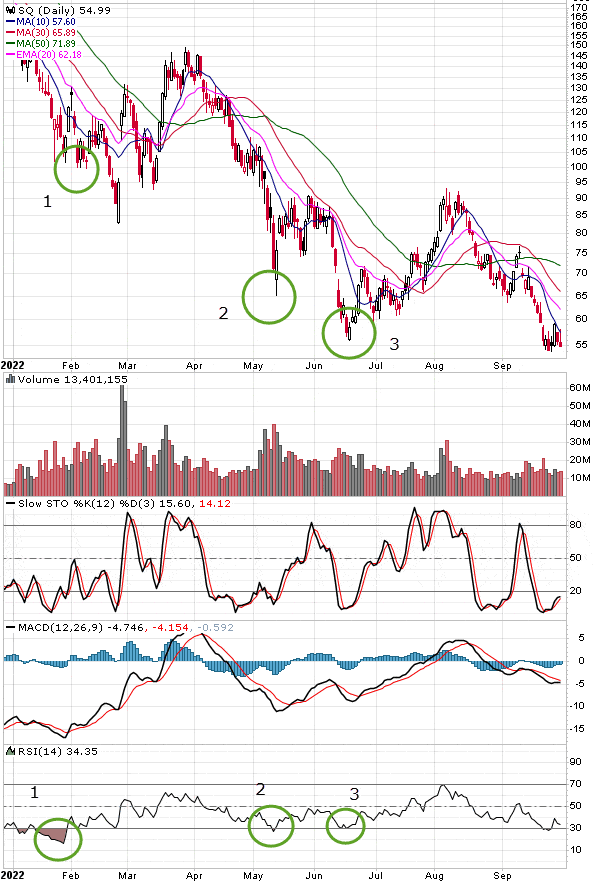The Holy Grail in Trading?
It seems like all new traders are looking for the holy grail trading strategy. One that has a near 100% win rate and can be used in all markets.
Sometimes what is touted is a magic indicator. Just wait for the indicator to flash green and you nearly always have a winning trade.
This week we will look at these typical “holy grail” strategies and debunk each of them. So we can save you some money by not buying into the hype.
The Mythical “Bullish Divergence”
This one seems to be ever popular at the moment. They tell you that you can wait for a stock that is making lower swing lows with higher swing lows on RSI, stochastics, MACD or another momentum measure.
The pattern is said to be divergent because the price is making lower lows while the indicator is making higher lows.
Here is an example from one of the former wall street darling growth names.

Chart courtesy of StockCharts.com
In the chart above you can see how the price makes lower swing lows on 3 occasions while both the RSI and MACD is making higher lows. Each time this occurred, you had bullish technical entry points using various entry strategies followed by a very short-term bounce or no bounce at all.
Shortly afterwards, the price fell sharply again to make new lows. In fact, its looking very bearish again right now with RSI now making lower lows.
After being bullish divergent for many months, the stock continues to make new 52-week lows. This is why we generally avoid stocks below a declining 200 day moving average for a long trade.
A bottoming process can easily take months or years to play out.
Many, many stocks have had similar price action and have been “bullish divergent” for most of this year. Buying into the bullish divergence hype would have yielded losses over and over.
This also gets back to one of the worst things you can do when trading – trying to pick a bottom.
Sure, eventually the stock might bottom. But then again, many stocks just keep going lower over many years.
Bearish Divergence
A “bearish divergence” is when the price makes higher highs with lower highs usually on a momentum indicator. This “bearish divergence” can, again, go on for years.
Its more interesting to us to gauge the strength of the long-term trend and watch how the stock consolidates within that trend.
A bullish or bearish divergence is good to take note of but is certainly no holy grail. Not even close. It may be one piece of the puzzle but that is about it.
Gap and Go Patterns
Gap and go patterns are often touted by day trading strategies offered online. Just wait for a stock with a good daily chart and a 4% or more gap and just jump in on the break of the pre-market high. This strategy is even worse when used on penny stocks.
What often happens is that these patterns will work for a few days and newer traders will notice this. They then start trading these patterns long on the break of the pre-market high because they haven’t done enough back-testing or enough experience to know better.
What happens next?
After newer traders notice the winners and start trading them, these “gap and go patterns” get pummeled later that week.
After trading daily for many years, we continue to see this all the time. After miserable performance for a while, they start working again, suck more newer traders into them and then take them to the cleaners. Its a repeating cycle.
A better strategy in a bear market? Wait for the market to become oversold and look for stocks over $20 that are gapping over 15% on very good news. These often provide some of the best short-term trades for day traders. Especially on the stocks that open closer to the pre-market high and above a flat to rising 200 day moving average.
The best strategy for gap and go patterns that we have found is the earnings eruptions strategy. We have a list of specific criteria for the stock, earnings report and market environment to know whether to trade the stock. After tens of thousands of day trades, this is one of our favorite day trading strategies.
We are gearing up for some big earnings gap trades once earnings season really picks up later this month. This could coincide with a market rebound and we could see some whoppers like we saw with ENPH and SWAV last quarter.
The Real Holy Grail in Trading
When you trade, you are in the probability business. In other words, you want only the ideal trading opportunities that have the highest likelihood to succeed with a good risk/reward ratio.
But there is no strategy that always works when trading. No holy grail unfortunately.
The closest we have found is to take a solid time-tested strategy, take time to study and back-test to figure out what an ideal trade looks like that fits the strategy, and work to become better at trading it over time. This includes reviewing your trades and correcting your limiting tendencies over time while identifying market conditions where the strategy tends to do well and tends to do poorly.
So instead of a bull flag, we play a high tight flag while focusing on the ones that meet the requirements in the high tight flag course. Instead of a bullish divergence, we look for the explosive bottoming pattern and double bottoms that are ideal.
So not just one indicator, several technical and fundamental characteristics along with market conditions that support the success of the trade at the time it reaches the technical entry point.
It takes a lot of patience and requires a lot of work but can pay off over time.
We are building our watch list constantly and will be eyeing many great bottoming and breakout patterns in the weeks ahead. If the conditions are right when the price reaches a good entry point, we will be ready to act with a good trading plan.
Our Top Longs and Shorts for the Weeks Ahead





Great article Brian. Indicators like RSI can help confirm an already-good trade (or be wary of a doubtful one), but not a holy grail. We’ve all been burned on other people’s quick-and-dirty strategies that eventually fail. But, we learn from our mistakes and improve from them.
As stated in Monty Python’s Holy Grail: “Well she turned me into a newt…I got better” – Peasant